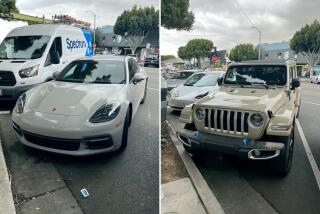No Cladding Around
- Share via
General Motors Corp.’s product development czar has given us a glimpse of where he wants to take GM by unveiling a new design direction for Pontiac.
Gone is the raked plastic cladding on the sides of the cars--the stuff that seemed to engulf the hapless Aztek.
At the recent Chicago Auto Show, GM Vice Chairman Robert A. Lutz showed retooled Sunfire and Bonneville models--cars sans cladding--as well as a smooth-sided sedan that presages the next-generation Grand Prix.
The Grand Prix G-Force concept will be the basis for the production 2004 Grand Prix, scheduled to hit showrooms next year and one of the first cars tweaked by Lutz since he joined GM in September.
The 70-year-old Lutz, a former Chrysler Corp. president and chief executive, said he took one look at the Grand Prix under development and saw that the trademark double-intake grille was too high, making the front of the car look as if it were sporting oversized buck teeth. The car had even been nicknamed Alvin, after the animated singing chipmunk--but nobody was willing to speak out. Lutz immediately ordered the grille repositioned.
Lutz says that revitalizing Pontiac and Cadillac are his top priorities and insists that the process of stripping down the Pontiacs will reveal a beauty that was there but camouflaged.
“I think cladding was a good way to differentiate Pontiac from other cars, but when you look at this Bonneville that’s been decladded and smoothed out, it permits the fundamentally gorgeous, just gorgeous, shape ... to become fully visible, and you’re not distracted by all these other elements,” he said.
So off came the side ribbing, first with the 2002 Aztek and then with the 2003 Sunfire.
“We were already starting to move in that direction,” said Lynn Myers, Pontiac’s general manager.
But under Lutz, “we accelerated a little bit,” she said. “And once we started down that road, it happened very quickly. It gets us into the 21st century.”
It is happening none too soon for many design experts, who have long castigated GM for wrapping Pontiacs in horizontal striations.
“What in the world were they thinking when they allowed that to happen?” said Dan Gorrell, vice president of San Diego-based marketing consultancy Strategic Vision. “It makes the cars look so cheap and substandard.
“When they look cheap, even if they’re not, people are going to stay away from them. When you have an image problem, you should at least dress well.”
Pontiac has had a mixed past. It was almost eliminated in the 1950s because of poor sales, then saw its heyday in the ‘60s with the Grand Prix coupe and the legendary 375-horsepower GTO, one of the premier muscle cars.
In the mid-1970s, Pontiac developed a hot Corvette-like two-seater prototype called the Banshee--put together by the division’s chief engineer, a man with a vision named John Z. DeLorean.
Pontiac has had more consistent styling among its vehicles than any other GM division--cat’s-eye headlights, the double grille, the ribbed plastic cladding.
Bryon Fitzpatrick, a former auto designer and now chairman of the industrial design department at the College of Creative Studies in Detroit, remembers Pontiacs of the 1950s and ‘60s with a distinct line of chrome up the center of the hood and down the trunk.
Then Pontiacs got soft and became “me-too” GM cars.
“They seemed to have sunk into the mire in the last few years, full of mediocrity. All you had left was the cladding--in plastic,” Fitzpatrick said. “The good news is they’re getting rid of it, and that’s a move in the right direction.”
Acting on Lutz’s orders, GM designers in a matter of weeks came up with the Pontiac Solstice two-seater concept car for the North American International Auto Show in Detroit in January.
“You look at the Solstice roadster and coupe, which is a redefinition of clean styling--that’s where we’re going with Pontiac: a much more international, European direction with very, very clean surfaces and a very strong front end,” Lutz said.
Although GM has not announced a decision to make the Solstice, the auto maker did release an expected price of $25,000--meaning the company is seriously considering it to enhance Pontiac’s new design character.
“Over the last few years the identity has depended too heavily on side moldings and looked crude and cheap, not adding to the image GM wanted,” says Geoff Wardle, an automotive design instructor at Art Center College of Design in Pasadena. “They always looked a bit toylike.”
He said he likes the direction of the latest Pontiac styling efforts, noting: “Now they look more solid, more refined and just as sporty.”
Pontiac’s Vibe, a sport-utility-like station wagon developed with Toyota Motor Corp. (which sells its version as the Matrix), has just gone on sale, and Pontiac executives hope it will attract more youthful buyers to the brand.
Pontiac’s next sporty addition, however, could come from an entirely different source: Australia.
GM is said to be considering importing as many as 20,000 Monaros to the U.S. from Holden, its Australian brand. They would be badged here as Pontiacs if the car can be made to meet American safety standards.
The Monaro has a 5.7-liter, 402-horsepower V-8 engine and could signal a nostalgic rebirth of the GTO marque in today’s market.
GM won’t confirm anything, but Lutz recently visited Holden’s facilities Down Under and said of the Monaro:
“Assuming affordability, there isn’t one guy in the United States who wouldn’t like to have it sooner rather than later.”
*
Terril Yue Jones, The Times’ Detroit bureau chief, covers autos for Highway 1 and the Business section. He can be reached at [email protected].




